Corporate Strategy and IT Governance Assignment
VerifiedAdded on 2020/05/01
|10
|2534
|32
AI Summary
Contribute Materials
Your contribution can guide someone’s learning journey. Share your
documents today.

Corporate Strategy & IT governance
Open Source Software
OCTOBER 27, 2017
Open Source Software
OCTOBER 27, 2017
Secure Best Marks with AI Grader
Need help grading? Try our AI Grader for instant feedback on your assignments.

Open Source Software
Table of Contents
Introduction...........................................................................................................................................2
Issues of Adopting Open Source Software (OSS).................................................................................2
Platform Compatibility......................................................................................................................2
Pre-Release Review...........................................................................................................................2
Legal Issues.......................................................................................................................................3
Security Issues...................................................................................................................................3
Poor Documentation..........................................................................................................................4
Issues in the Transition Process.............................................................................................................5
Comparison between OSS & Proprietary Software...............................................................................6
Recommendation & Conclusion............................................................................................................7
Annotated Bibliography.........................................................................................................................8
1
Table of Contents
Introduction...........................................................................................................................................2
Issues of Adopting Open Source Software (OSS).................................................................................2
Platform Compatibility......................................................................................................................2
Pre-Release Review...........................................................................................................................2
Legal Issues.......................................................................................................................................3
Security Issues...................................................................................................................................3
Poor Documentation..........................................................................................................................4
Issues in the Transition Process.............................................................................................................5
Comparison between OSS & Proprietary Software...............................................................................6
Recommendation & Conclusion............................................................................................................7
Annotated Bibliography.........................................................................................................................8
1
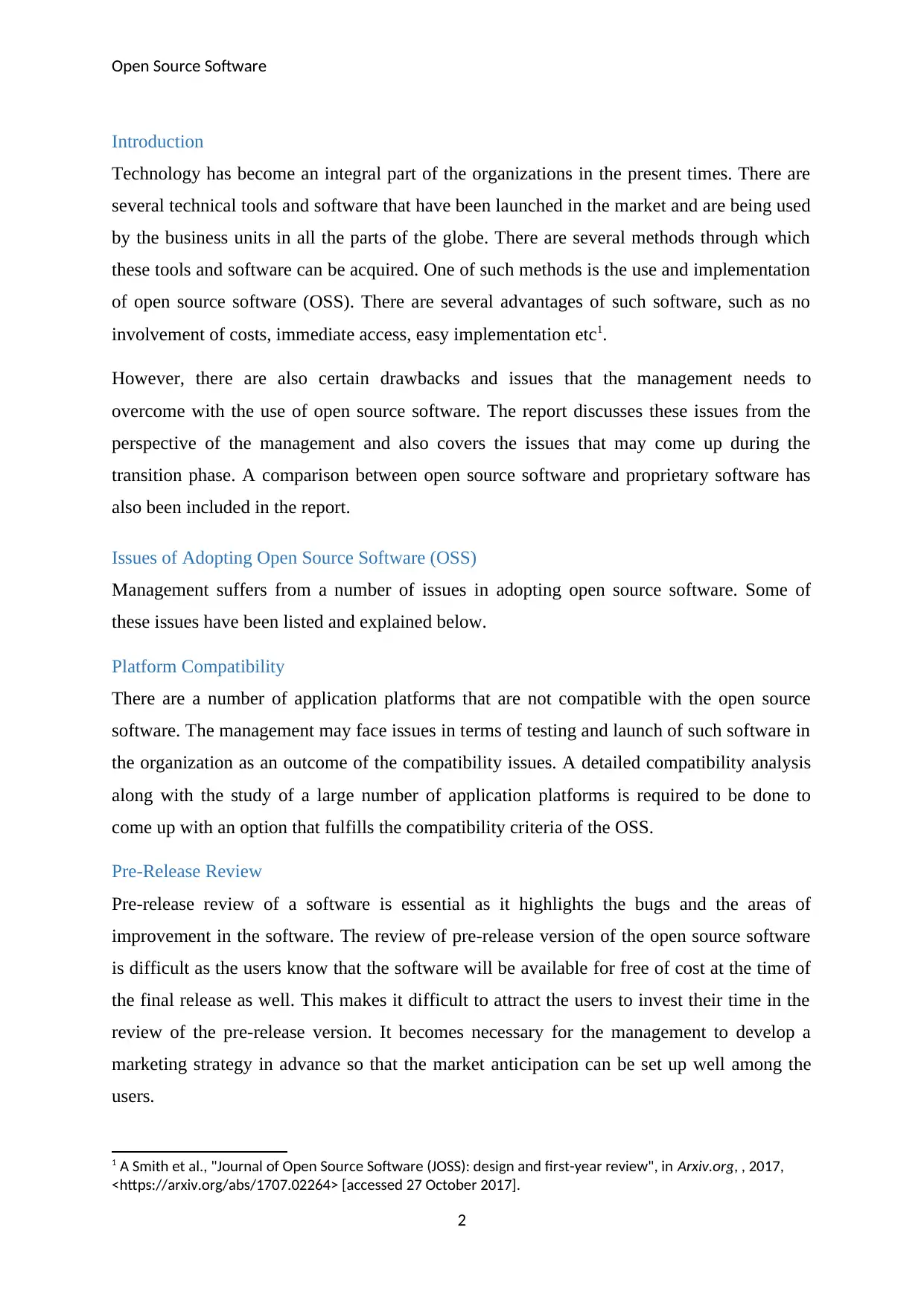
Open Source Software
Introduction
Technology has become an integral part of the organizations in the present times. There are
several technical tools and software that have been launched in the market and are being used
by the business units in all the parts of the globe. There are several methods through which
these tools and software can be acquired. One of such methods is the use and implementation
of open source software (OSS). There are several advantages of such software, such as no
involvement of costs, immediate access, easy implementation etc1.
However, there are also certain drawbacks and issues that the management needs to
overcome with the use of open source software. The report discusses these issues from the
perspective of the management and also covers the issues that may come up during the
transition phase. A comparison between open source software and proprietary software has
also been included in the report.
Issues of Adopting Open Source Software (OSS)
Management suffers from a number of issues in adopting open source software. Some of
these issues have been listed and explained below.
Platform Compatibility
There are a number of application platforms that are not compatible with the open source
software. The management may face issues in terms of testing and launch of such software in
the organization as an outcome of the compatibility issues. A detailed compatibility analysis
along with the study of a large number of application platforms is required to be done to
come up with an option that fulfills the compatibility criteria of the OSS.
Pre-Release Review
Pre-release review of a software is essential as it highlights the bugs and the areas of
improvement in the software. The review of pre-release version of the open source software
is difficult as the users know that the software will be available for free of cost at the time of
the final release as well. This makes it difficult to attract the users to invest their time in the
review of the pre-release version. It becomes necessary for the management to develop a
marketing strategy in advance so that the market anticipation can be set up well among the
users.
1 A Smith et al., "Journal of Open Source Software (JOSS): design and first-year review", in Arxiv.org, , 2017,
<https://arxiv.org/abs/1707.02264> [accessed 27 October 2017].
2
Introduction
Technology has become an integral part of the organizations in the present times. There are
several technical tools and software that have been launched in the market and are being used
by the business units in all the parts of the globe. There are several methods through which
these tools and software can be acquired. One of such methods is the use and implementation
of open source software (OSS). There are several advantages of such software, such as no
involvement of costs, immediate access, easy implementation etc1.
However, there are also certain drawbacks and issues that the management needs to
overcome with the use of open source software. The report discusses these issues from the
perspective of the management and also covers the issues that may come up during the
transition phase. A comparison between open source software and proprietary software has
also been included in the report.
Issues of Adopting Open Source Software (OSS)
Management suffers from a number of issues in adopting open source software. Some of
these issues have been listed and explained below.
Platform Compatibility
There are a number of application platforms that are not compatible with the open source
software. The management may face issues in terms of testing and launch of such software in
the organization as an outcome of the compatibility issues. A detailed compatibility analysis
along with the study of a large number of application platforms is required to be done to
come up with an option that fulfills the compatibility criteria of the OSS.
Pre-Release Review
Pre-release review of a software is essential as it highlights the bugs and the areas of
improvement in the software. The review of pre-release version of the open source software
is difficult as the users know that the software will be available for free of cost at the time of
the final release as well. This makes it difficult to attract the users to invest their time in the
review of the pre-release version. It becomes necessary for the management to develop a
marketing strategy in advance so that the market anticipation can be set up well among the
users.
1 A Smith et al., "Journal of Open Source Software (JOSS): design and first-year review", in Arxiv.org, , 2017,
<https://arxiv.org/abs/1707.02264> [accessed 27 October 2017].
2
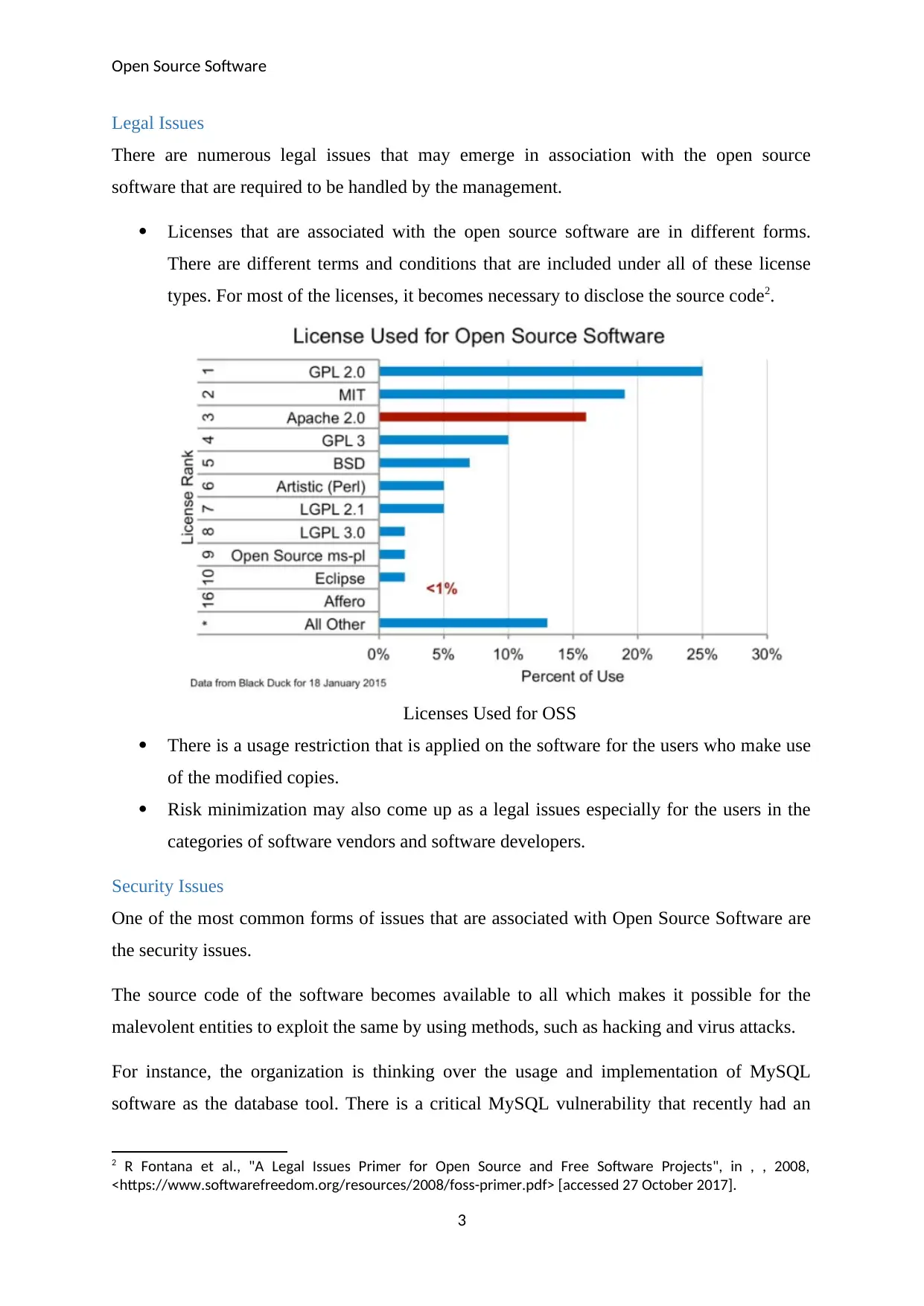
Open Source Software
Legal Issues
There are numerous legal issues that may emerge in association with the open source
software that are required to be handled by the management.
Licenses that are associated with the open source software are in different forms.
There are different terms and conditions that are included under all of these license
types. For most of the licenses, it becomes necessary to disclose the source code2.
Licenses Used for OSS
There is a usage restriction that is applied on the software for the users who make use
of the modified copies.
Risk minimization may also come up as a legal issues especially for the users in the
categories of software vendors and software developers.
Security Issues
One of the most common forms of issues that are associated with Open Source Software are
the security issues.
The source code of the software becomes available to all which makes it possible for the
malevolent entities to exploit the same by using methods, such as hacking and virus attacks.
For instance, the organization is thinking over the usage and implementation of MySQL
software as the database tool. There is a critical MySQL vulnerability that recently had an
2 R Fontana et al., "A Legal Issues Primer for Open Source and Free Software Projects", in , , 2008,
<https://www.softwarefreedom.org/resources/2008/foss-primer.pdf> [accessed 27 October 2017].
3
Legal Issues
There are numerous legal issues that may emerge in association with the open source
software that are required to be handled by the management.
Licenses that are associated with the open source software are in different forms.
There are different terms and conditions that are included under all of these license
types. For most of the licenses, it becomes necessary to disclose the source code2.
Licenses Used for OSS
There is a usage restriction that is applied on the software for the users who make use
of the modified copies.
Risk minimization may also come up as a legal issues especially for the users in the
categories of software vendors and software developers.
Security Issues
One of the most common forms of issues that are associated with Open Source Software are
the security issues.
The source code of the software becomes available to all which makes it possible for the
malevolent entities to exploit the same by using methods, such as hacking and virus attacks.
For instance, the organization is thinking over the usage and implementation of MySQL
software as the database tool. There is a critical MySQL vulnerability that recently had an
2 R Fontana et al., "A Legal Issues Primer for Open Source and Free Software Projects", in , , 2008,
<https://www.softwarefreedom.org/resources/2008/foss-primer.pdf> [accessed 27 October 2017].
3
Secure Best Marks with AI Grader
Need help grading? Try our AI Grader for instant feedback on your assignments.
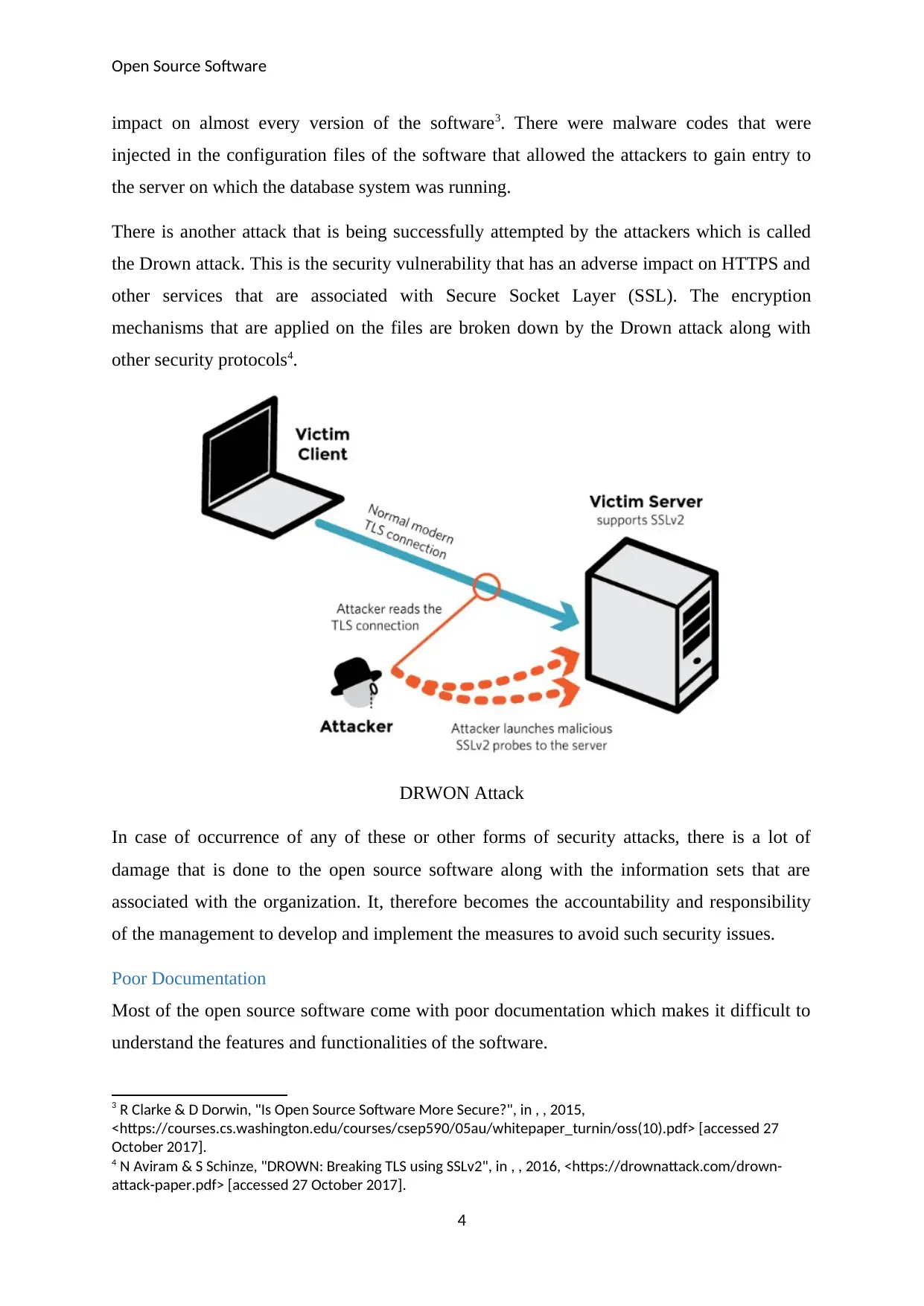
Open Source Software
impact on almost every version of the software3. There were malware codes that were
injected in the configuration files of the software that allowed the attackers to gain entry to
the server on which the database system was running.
There is another attack that is being successfully attempted by the attackers which is called
the Drown attack. This is the security vulnerability that has an adverse impact on HTTPS and
other services that are associated with Secure Socket Layer (SSL). The encryption
mechanisms that are applied on the files are broken down by the Drown attack along with
other security protocols4.
DRWON Attack
In case of occurrence of any of these or other forms of security attacks, there is a lot of
damage that is done to the open source software along with the information sets that are
associated with the organization. It, therefore becomes the accountability and responsibility
of the management to develop and implement the measures to avoid such security issues.
Poor Documentation
Most of the open source software come with poor documentation which makes it difficult to
understand the features and functionalities of the software.
3 R Clarke & D Dorwin, "Is Open Source Software More Secure?", in , , 2015,
<https://courses.cs.washington.edu/courses/csep590/05au/whitepaper_turnin/oss(10).pdf> [accessed 27
October 2017].
4 N Aviram & S Schinze, "DROWN: Breaking TLS using SSLv2", in , , 2016, <https://drownattack.com/drown-
attack-paper.pdf> [accessed 27 October 2017].
4
impact on almost every version of the software3. There were malware codes that were
injected in the configuration files of the software that allowed the attackers to gain entry to
the server on which the database system was running.
There is another attack that is being successfully attempted by the attackers which is called
the Drown attack. This is the security vulnerability that has an adverse impact on HTTPS and
other services that are associated with Secure Socket Layer (SSL). The encryption
mechanisms that are applied on the files are broken down by the Drown attack along with
other security protocols4.
DRWON Attack
In case of occurrence of any of these or other forms of security attacks, there is a lot of
damage that is done to the open source software along with the information sets that are
associated with the organization. It, therefore becomes the accountability and responsibility
of the management to develop and implement the measures to avoid such security issues.
Poor Documentation
Most of the open source software come with poor documentation which makes it difficult to
understand the features and functionalities of the software.
3 R Clarke & D Dorwin, "Is Open Source Software More Secure?", in , , 2015,
<https://courses.cs.washington.edu/courses/csep590/05au/whitepaper_turnin/oss(10).pdf> [accessed 27
October 2017].
4 N Aviram & S Schinze, "DROWN: Breaking TLS using SSLv2", in , , 2016, <https://drownattack.com/drown-
attack-paper.pdf> [accessed 27 October 2017].
4
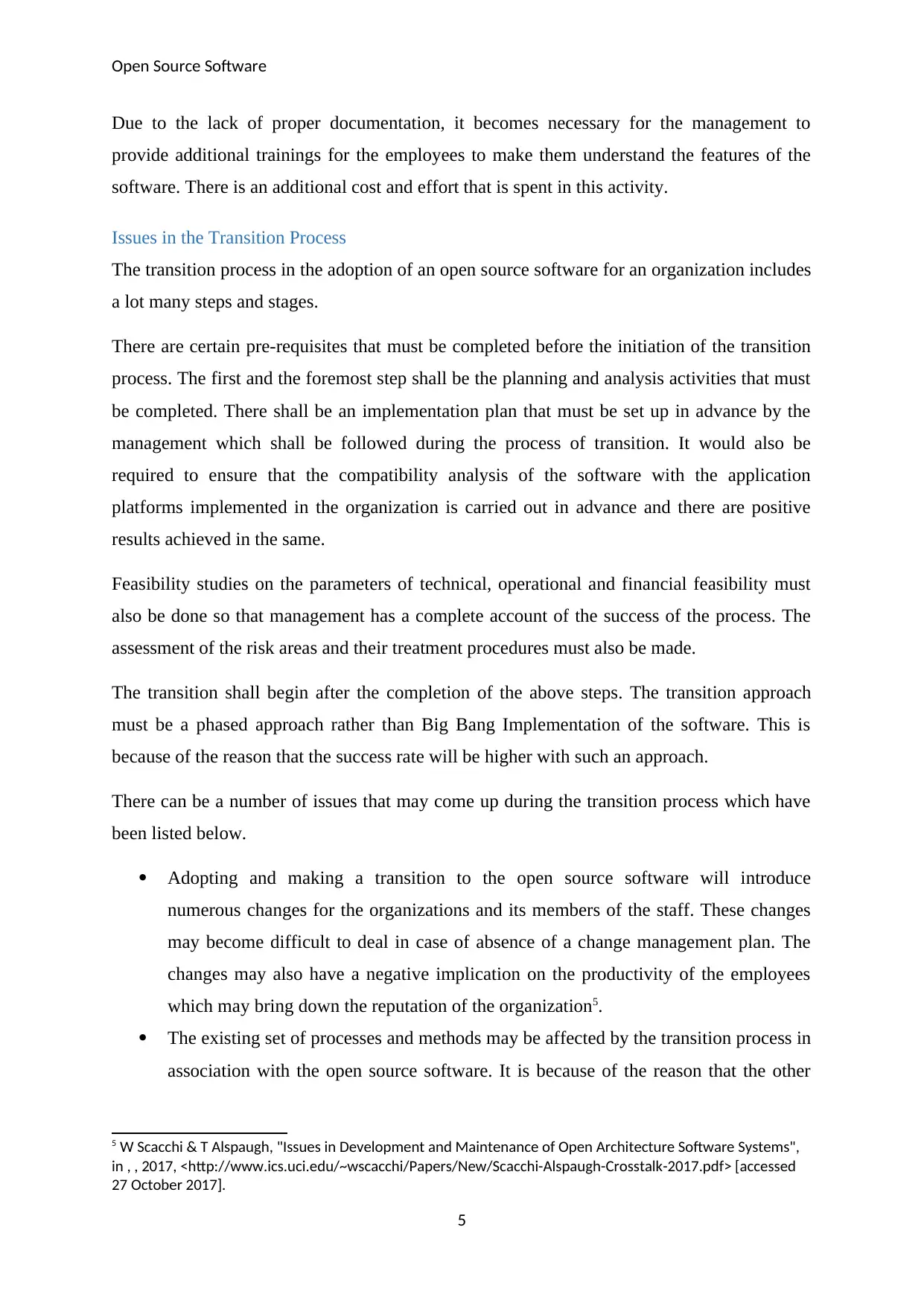
Open Source Software
Due to the lack of proper documentation, it becomes necessary for the management to
provide additional trainings for the employees to make them understand the features of the
software. There is an additional cost and effort that is spent in this activity.
Issues in the Transition Process
The transition process in the adoption of an open source software for an organization includes
a lot many steps and stages.
There are certain pre-requisites that must be completed before the initiation of the transition
process. The first and the foremost step shall be the planning and analysis activities that must
be completed. There shall be an implementation plan that must be set up in advance by the
management which shall be followed during the process of transition. It would also be
required to ensure that the compatibility analysis of the software with the application
platforms implemented in the organization is carried out in advance and there are positive
results achieved in the same.
Feasibility studies on the parameters of technical, operational and financial feasibility must
also be done so that management has a complete account of the success of the process. The
assessment of the risk areas and their treatment procedures must also be made.
The transition shall begin after the completion of the above steps. The transition approach
must be a phased approach rather than Big Bang Implementation of the software. This is
because of the reason that the success rate will be higher with such an approach.
There can be a number of issues that may come up during the transition process which have
been listed below.
Adopting and making a transition to the open source software will introduce
numerous changes for the organizations and its members of the staff. These changes
may become difficult to deal in case of absence of a change management plan. The
changes may also have a negative implication on the productivity of the employees
which may bring down the reputation of the organization5.
The existing set of processes and methods may be affected by the transition process in
association with the open source software. It is because of the reason that the other
5 W Scacchi & T Alspaugh, "Issues in Development and Maintenance of Open Architecture Software Systems",
in , , 2017, <http://www.ics.uci.edu/~wscacchi/Papers/New/Scacchi-Alspaugh-Crosstalk-2017.pdf> [accessed
27 October 2017].
5
Due to the lack of proper documentation, it becomes necessary for the management to
provide additional trainings for the employees to make them understand the features of the
software. There is an additional cost and effort that is spent in this activity.
Issues in the Transition Process
The transition process in the adoption of an open source software for an organization includes
a lot many steps and stages.
There are certain pre-requisites that must be completed before the initiation of the transition
process. The first and the foremost step shall be the planning and analysis activities that must
be completed. There shall be an implementation plan that must be set up in advance by the
management which shall be followed during the process of transition. It would also be
required to ensure that the compatibility analysis of the software with the application
platforms implemented in the organization is carried out in advance and there are positive
results achieved in the same.
Feasibility studies on the parameters of technical, operational and financial feasibility must
also be done so that management has a complete account of the success of the process. The
assessment of the risk areas and their treatment procedures must also be made.
The transition shall begin after the completion of the above steps. The transition approach
must be a phased approach rather than Big Bang Implementation of the software. This is
because of the reason that the success rate will be higher with such an approach.
There can be a number of issues that may come up during the transition process which have
been listed below.
Adopting and making a transition to the open source software will introduce
numerous changes for the organizations and its members of the staff. These changes
may become difficult to deal in case of absence of a change management plan. The
changes may also have a negative implication on the productivity of the employees
which may bring down the reputation of the organization5.
The existing set of processes and methods may be affected by the transition process in
association with the open source software. It is because of the reason that the other
5 W Scacchi & T Alspaugh, "Issues in Development and Maintenance of Open Architecture Software Systems",
in , , 2017, <http://www.ics.uci.edu/~wscacchi/Papers/New/Scacchi-Alspaugh-Crosstalk-2017.pdf> [accessed
27 October 2017].
5
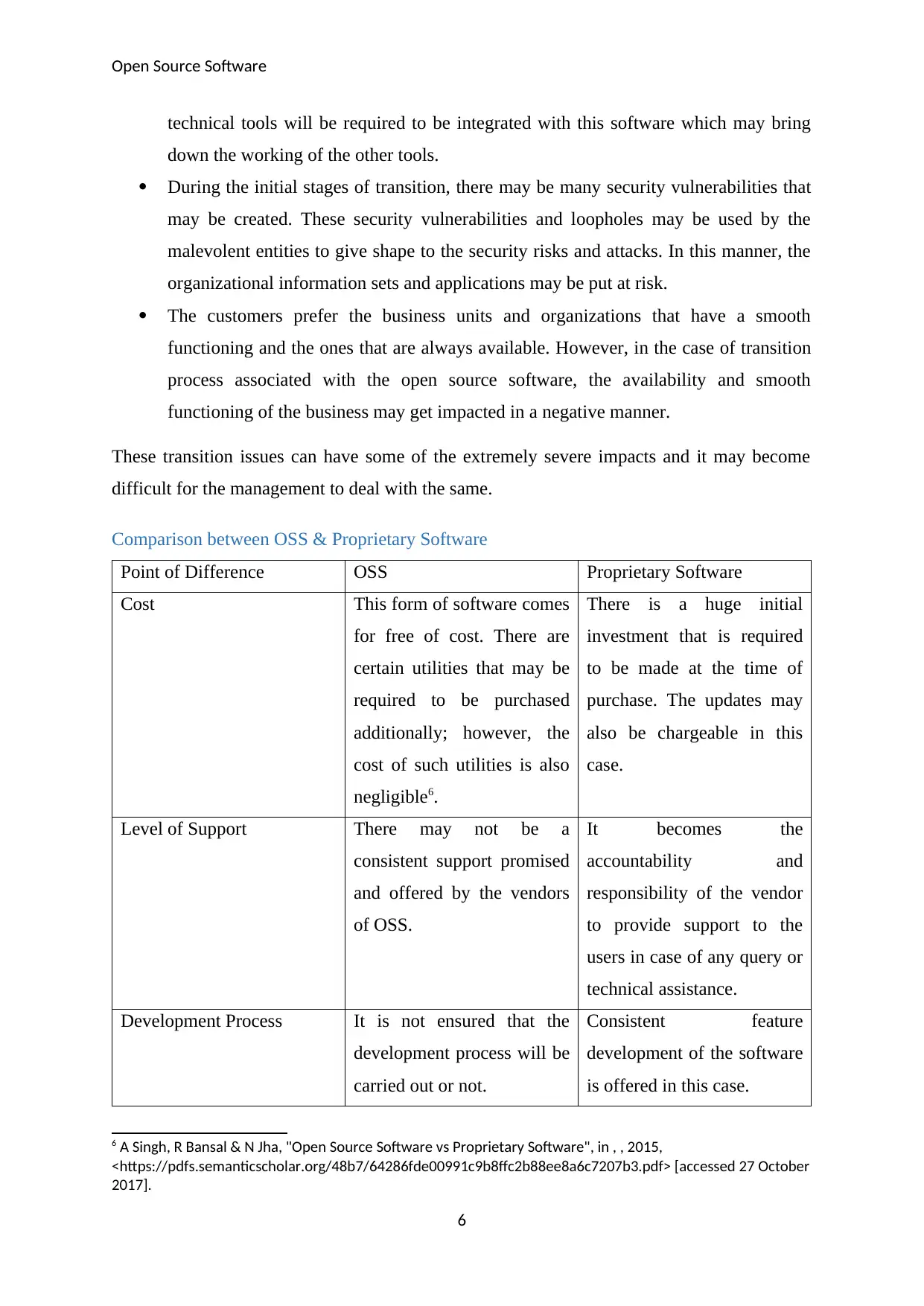
Open Source Software
technical tools will be required to be integrated with this software which may bring
down the working of the other tools.
During the initial stages of transition, there may be many security vulnerabilities that
may be created. These security vulnerabilities and loopholes may be used by the
malevolent entities to give shape to the security risks and attacks. In this manner, the
organizational information sets and applications may be put at risk.
The customers prefer the business units and organizations that have a smooth
functioning and the ones that are always available. However, in the case of transition
process associated with the open source software, the availability and smooth
functioning of the business may get impacted in a negative manner.
These transition issues can have some of the extremely severe impacts and it may become
difficult for the management to deal with the same.
Comparison between OSS & Proprietary Software
Point of Difference OSS Proprietary Software
Cost This form of software comes
for free of cost. There are
certain utilities that may be
required to be purchased
additionally; however, the
cost of such utilities is also
negligible6.
There is a huge initial
investment that is required
to be made at the time of
purchase. The updates may
also be chargeable in this
case.
Level of Support There may not be a
consistent support promised
and offered by the vendors
of OSS.
It becomes the
accountability and
responsibility of the vendor
to provide support to the
users in case of any query or
technical assistance.
Development Process It is not ensured that the
development process will be
carried out or not.
Consistent feature
development of the software
is offered in this case.
6 A Singh, R Bansal & N Jha, "Open Source Software vs Proprietary Software", in , , 2015,
<https://pdfs.semanticscholar.org/48b7/64286fde00991c9b8ffc2b88ee8a6c7207b3.pdf> [accessed 27 October
2017].
6
technical tools will be required to be integrated with this software which may bring
down the working of the other tools.
During the initial stages of transition, there may be many security vulnerabilities that
may be created. These security vulnerabilities and loopholes may be used by the
malevolent entities to give shape to the security risks and attacks. In this manner, the
organizational information sets and applications may be put at risk.
The customers prefer the business units and organizations that have a smooth
functioning and the ones that are always available. However, in the case of transition
process associated with the open source software, the availability and smooth
functioning of the business may get impacted in a negative manner.
These transition issues can have some of the extremely severe impacts and it may become
difficult for the management to deal with the same.
Comparison between OSS & Proprietary Software
Point of Difference OSS Proprietary Software
Cost This form of software comes
for free of cost. There are
certain utilities that may be
required to be purchased
additionally; however, the
cost of such utilities is also
negligible6.
There is a huge initial
investment that is required
to be made at the time of
purchase. The updates may
also be chargeable in this
case.
Level of Support There may not be a
consistent support promised
and offered by the vendors
of OSS.
It becomes the
accountability and
responsibility of the vendor
to provide support to the
users in case of any query or
technical assistance.
Development Process It is not ensured that the
development process will be
carried out or not.
Consistent feature
development of the software
is offered in this case.
6 A Singh, R Bansal & N Jha, "Open Source Software vs Proprietary Software", in , , 2015,
<https://pdfs.semanticscholar.org/48b7/64286fde00991c9b8ffc2b88ee8a6c7207b3.pdf> [accessed 27 October
2017].
6
Paraphrase This Document
Need a fresh take? Get an instant paraphrase of this document with our AI Paraphraser
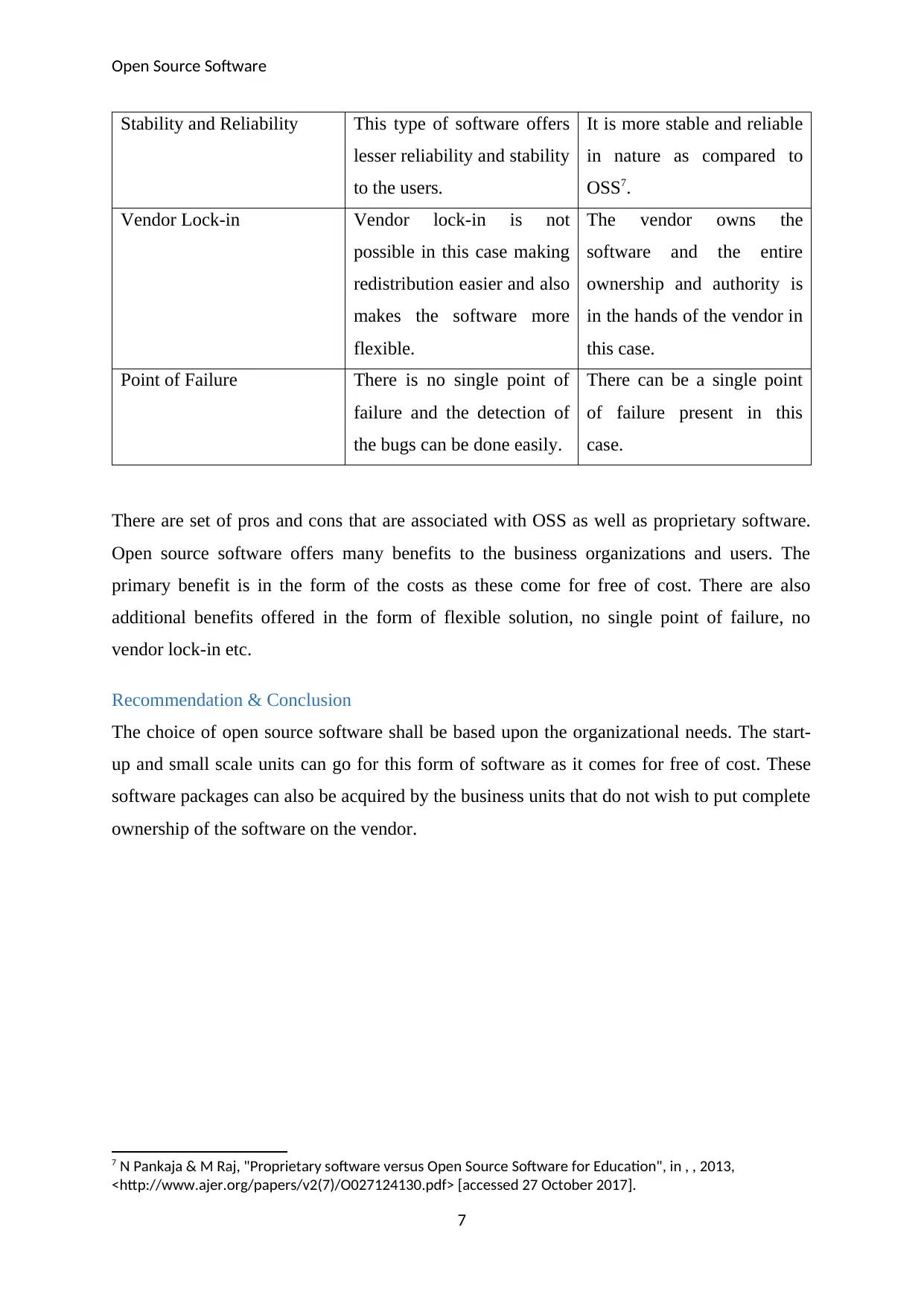
Open Source Software
Stability and Reliability This type of software offers
lesser reliability and stability
to the users.
It is more stable and reliable
in nature as compared to
OSS7.
Vendor Lock-in Vendor lock-in is not
possible in this case making
redistribution easier and also
makes the software more
flexible.
The vendor owns the
software and the entire
ownership and authority is
in the hands of the vendor in
this case.
Point of Failure There is no single point of
failure and the detection of
the bugs can be done easily.
There can be a single point
of failure present in this
case.
There are set of pros and cons that are associated with OSS as well as proprietary software.
Open source software offers many benefits to the business organizations and users. The
primary benefit is in the form of the costs as these come for free of cost. There are also
additional benefits offered in the form of flexible solution, no single point of failure, no
vendor lock-in etc.
Recommendation & Conclusion
The choice of open source software shall be based upon the organizational needs. The start-
up and small scale units can go for this form of software as it comes for free of cost. These
software packages can also be acquired by the business units that do not wish to put complete
ownership of the software on the vendor.
7 N Pankaja & M Raj, "Proprietary software versus Open Source Software for Education", in , , 2013,
<http://www.ajer.org/papers/v2(7)/O027124130.pdf> [accessed 27 October 2017].
7
Stability and Reliability This type of software offers
lesser reliability and stability
to the users.
It is more stable and reliable
in nature as compared to
OSS7.
Vendor Lock-in Vendor lock-in is not
possible in this case making
redistribution easier and also
makes the software more
flexible.
The vendor owns the
software and the entire
ownership and authority is
in the hands of the vendor in
this case.
Point of Failure There is no single point of
failure and the detection of
the bugs can be done easily.
There can be a single point
of failure present in this
case.
There are set of pros and cons that are associated with OSS as well as proprietary software.
Open source software offers many benefits to the business organizations and users. The
primary benefit is in the form of the costs as these come for free of cost. There are also
additional benefits offered in the form of flexible solution, no single point of failure, no
vendor lock-in etc.
Recommendation & Conclusion
The choice of open source software shall be based upon the organizational needs. The start-
up and small scale units can go for this form of software as it comes for free of cost. These
software packages can also be acquired by the business units that do not wish to put complete
ownership of the software on the vendor.
7 N Pankaja & M Raj, "Proprietary software versus Open Source Software for Education", in , , 2013,
<http://www.ajer.org/papers/v2(7)/O027124130.pdf> [accessed 27 October 2017].
7

Open Source Software
Annotated Bibliography
1. Aviram, N, & S Schinze, "DROWN: Breaking TLS using SSLv2.". in , , 2016,
<https://drownattack.com/drown-attack-paper.pdf> [accessed 27 October 2017].
Aviram and Schinzel have covered the details of the DROWN attack in their article. The
meaning and background of the attack along with its mechanism has been covered. There is
good use of figures and tables done in the article to support the information that is covered.
The authors could have also added the details on the case studies in the form of victims that
have been affected by this attack.
2. Clarke, R, & D Dorwin, "Is Open Source Software More Secure?.". in , , 2015,
<https://courses.cs.washington.edu/courses/csep590/05au/whitepaper_turnin/
oss(10).pdf> [accessed 27 October 2017].
The authors, Clarke and Dorwin, have covered the security issues that are associated with
OSS. Source dependent and source independent security vulnerabilities have been explained
by the authors along with the analysis of the security tools and socioeconomic factors. The
authors could have made use of the case studies to further strengthen their information and
details covered in the article.
3. Fontana, R, B Kuhn, E Moglen, M Norwood, D Ravicher, & K Sandler et al., "A
Legal Issues Primer for Open Source and Free Software Projects.". in , , 2008,
<https://www.softwarefreedom.org/resources/2008/foss-primer.pdf> [accessed 27
October 2017].
Richard and fellow authors have covered the several legal issues that are associated with the
open source software. The set of issues that have been covered include the licensing issues,
copyright enforcement issues, and patent and trademark issues along with many other
organizational issues in the legal framework. There is no use of graphics in the article which
could have been included.
4. Pankaja, N, & M Raj, "Proprietary software versus Open Source Software for
Education.". in , , 2013, <http://www.ajer.org/papers/v2(7)/O027124130.pdf>
[accessed 27 October 2017].
Pankaja and Raj have covered the comparison between proprietary and open source software
in the article. Definition of both of these software types and other models has been covered
8
Annotated Bibliography
1. Aviram, N, & S Schinze, "DROWN: Breaking TLS using SSLv2.". in , , 2016,
<https://drownattack.com/drown-attack-paper.pdf> [accessed 27 October 2017].
Aviram and Schinzel have covered the details of the DROWN attack in their article. The
meaning and background of the attack along with its mechanism has been covered. There is
good use of figures and tables done in the article to support the information that is covered.
The authors could have also added the details on the case studies in the form of victims that
have been affected by this attack.
2. Clarke, R, & D Dorwin, "Is Open Source Software More Secure?.". in , , 2015,
<https://courses.cs.washington.edu/courses/csep590/05au/whitepaper_turnin/
oss(10).pdf> [accessed 27 October 2017].
The authors, Clarke and Dorwin, have covered the security issues that are associated with
OSS. Source dependent and source independent security vulnerabilities have been explained
by the authors along with the analysis of the security tools and socioeconomic factors. The
authors could have made use of the case studies to further strengthen their information and
details covered in the article.
3. Fontana, R, B Kuhn, E Moglen, M Norwood, D Ravicher, & K Sandler et al., "A
Legal Issues Primer for Open Source and Free Software Projects.". in , , 2008,
<https://www.softwarefreedom.org/resources/2008/foss-primer.pdf> [accessed 27
October 2017].
Richard and fellow authors have covered the several legal issues that are associated with the
open source software. The set of issues that have been covered include the licensing issues,
copyright enforcement issues, and patent and trademark issues along with many other
organizational issues in the legal framework. There is no use of graphics in the article which
could have been included.
4. Pankaja, N, & M Raj, "Proprietary software versus Open Source Software for
Education.". in , , 2013, <http://www.ajer.org/papers/v2(7)/O027124130.pdf>
[accessed 27 October 2017].
Pankaja and Raj have covered the comparison between proprietary and open source software
in the article. Definition of both of these software types and other models has been covered
8
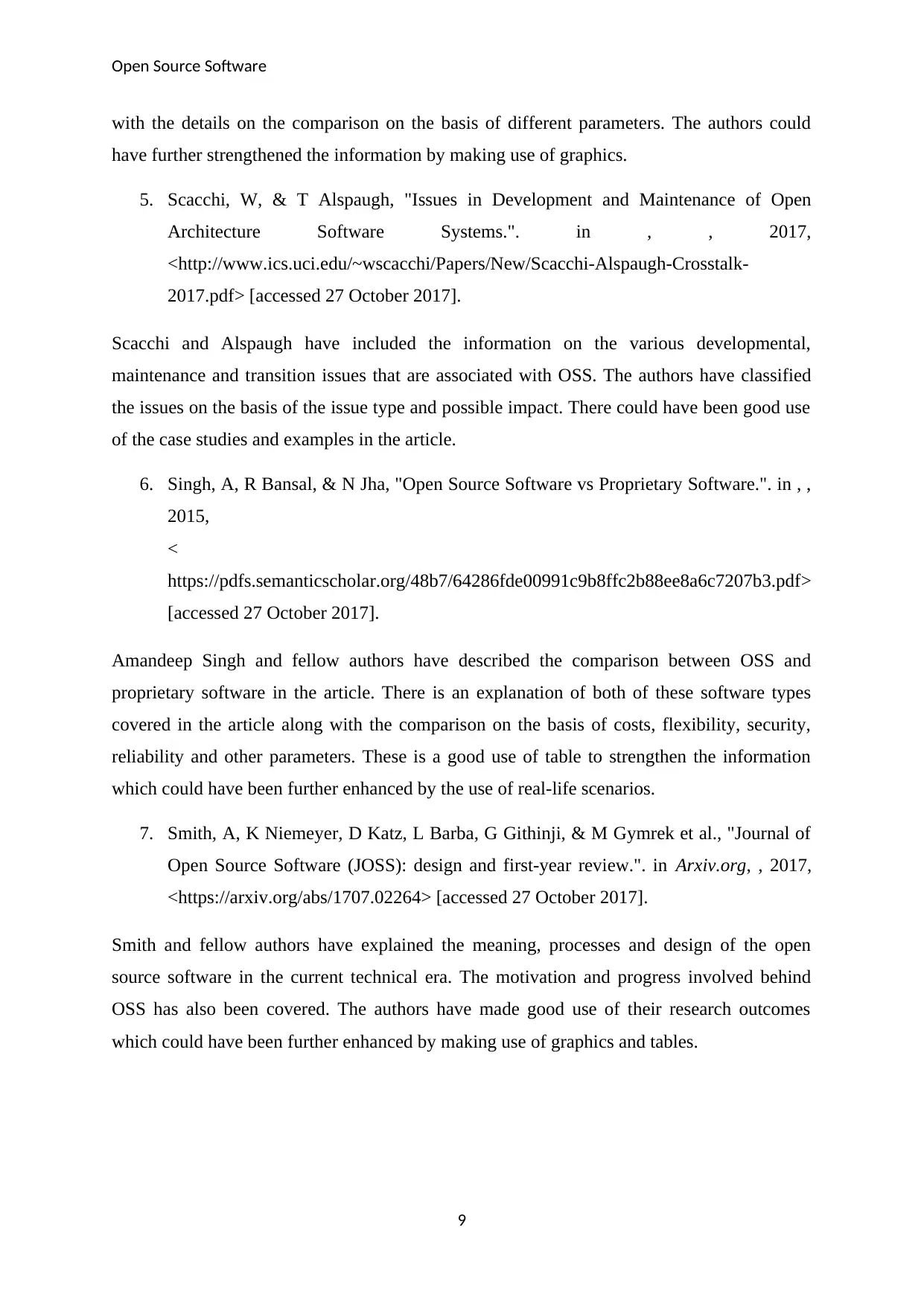
Open Source Software
with the details on the comparison on the basis of different parameters. The authors could
have further strengthened the information by making use of graphics.
5. Scacchi, W, & T Alspaugh, "Issues in Development and Maintenance of Open
Architecture Software Systems.". in , , 2017,
<http://www.ics.uci.edu/~wscacchi/Papers/New/Scacchi-Alspaugh-Crosstalk-
2017.pdf> [accessed 27 October 2017].
Scacchi and Alspaugh have included the information on the various developmental,
maintenance and transition issues that are associated with OSS. The authors have classified
the issues on the basis of the issue type and possible impact. There could have been good use
of the case studies and examples in the article.
6. Singh, A, R Bansal, & N Jha, "Open Source Software vs Proprietary Software.". in , ,
2015,
<
https://pdfs.semanticscholar.org/48b7/64286fde00991c9b8ffc2b88ee8a6c7207b3.pdf>
[accessed 27 October 2017].
Amandeep Singh and fellow authors have described the comparison between OSS and
proprietary software in the article. There is an explanation of both of these software types
covered in the article along with the comparison on the basis of costs, flexibility, security,
reliability and other parameters. These is a good use of table to strengthen the information
which could have been further enhanced by the use of real-life scenarios.
7. Smith, A, K Niemeyer, D Katz, L Barba, G Githinji, & M Gymrek et al., "Journal of
Open Source Software (JOSS): design and first-year review.". in Arxiv.org, , 2017,
<https://arxiv.org/abs/1707.02264> [accessed 27 October 2017].
Smith and fellow authors have explained the meaning, processes and design of the open
source software in the current technical era. The motivation and progress involved behind
OSS has also been covered. The authors have made good use of their research outcomes
which could have been further enhanced by making use of graphics and tables.
9
with the details on the comparison on the basis of different parameters. The authors could
have further strengthened the information by making use of graphics.
5. Scacchi, W, & T Alspaugh, "Issues in Development and Maintenance of Open
Architecture Software Systems.". in , , 2017,
<http://www.ics.uci.edu/~wscacchi/Papers/New/Scacchi-Alspaugh-Crosstalk-
2017.pdf> [accessed 27 October 2017].
Scacchi and Alspaugh have included the information on the various developmental,
maintenance and transition issues that are associated with OSS. The authors have classified
the issues on the basis of the issue type and possible impact. There could have been good use
of the case studies and examples in the article.
6. Singh, A, R Bansal, & N Jha, "Open Source Software vs Proprietary Software.". in , ,
2015,
<
https://pdfs.semanticscholar.org/48b7/64286fde00991c9b8ffc2b88ee8a6c7207b3.pdf>
[accessed 27 October 2017].
Amandeep Singh and fellow authors have described the comparison between OSS and
proprietary software in the article. There is an explanation of both of these software types
covered in the article along with the comparison on the basis of costs, flexibility, security,
reliability and other parameters. These is a good use of table to strengthen the information
which could have been further enhanced by the use of real-life scenarios.
7. Smith, A, K Niemeyer, D Katz, L Barba, G Githinji, & M Gymrek et al., "Journal of
Open Source Software (JOSS): design and first-year review.". in Arxiv.org, , 2017,
<https://arxiv.org/abs/1707.02264> [accessed 27 October 2017].
Smith and fellow authors have explained the meaning, processes and design of the open
source software in the current technical era. The motivation and progress involved behind
OSS has also been covered. The authors have made good use of their research outcomes
which could have been further enhanced by making use of graphics and tables.
9
1 out of 10
Your All-in-One AI-Powered Toolkit for Academic Success.
+13062052269
info@desklib.com
Available 24*7 on WhatsApp / Email
![[object Object]](/_next/static/media/star-bottom.7253800d.svg)
Unlock your academic potential
© 2024 | Zucol Services PVT LTD | All rights reserved.


